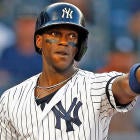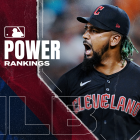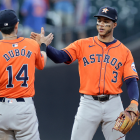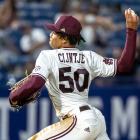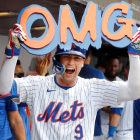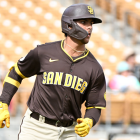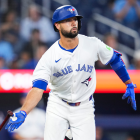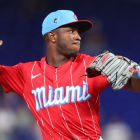It's that time of the year again, when we're whirred into a capitalistic frenzy by discounted prices. Everybody wants a deal, whether it's on [an item we won't provide free advertising for], or a relief pitcher. As such, we've decided to round up 10 free agents who we think could prove to be bargains.
By "bargains" we mean that their value might exceed their expected salaries. We're not glorifying underpaying players here; just acknowledging the reality of the situation: certain players (and/or player types) tend to be undercompensated relative to their output for various reasons.
Do note that the players below are listed in alphabetical order, and that the only requirement for inclusion was that the players in question were not included in the top 50 of our free-agent rankings.
Yes, Homer Bailey -- we're as surprised as anyone. Bailey, who will turn 34 in May, saved his career in 2019 by starting 31 times and managing a 99 ERA+ and 2.81 strikeout-to-walk ratio after a miserable four-year stretch that saw him average fewer than 12 starts per pop and a 69 ERA+. One key to his turnaround? An altered approach that saw Bailey lean on his four-seam fastball and his splitter, the best bat-misser in his arsenal. The downside will suppress Bailey's earnings, but he should open the season as someone's No. 4 or 5 starter -- and he could pitch better than that designation if he sticks to what works.
The busiest sector of the free-agent market has been the catching portion -- Yasmani Grandal and Travis d'Arnaud have each signed, taking two of the top three (or so) backstops out of play. Jason Castro isn't an everyday option at this stage of his career, but he's a fine reserve candidate who can provide value with his discerning eye and his above-average framing. Castro hit the ball harder last season than normal, and it's at least possible he'll retain some of that pop heading forward. To be fair, there's also a healthy amount of risk: his bat featured more swing-and-miss last season, too, and he's an aging catcher -- a fancy way of saying his body is, understandably, the baseball equivalent of a house of cards.
Speaking of volatile quantities, Tyler Clippard has quietly pieced together solid seasons the past two years. Don't believe us? He has a 135 ERA+ and a 3.92 strikeout-to-walk ratio to show for his last 126 appearances. You might think the altered baseball would prove ruinous for a dinger-prone pitcher like Clippard, but he instead yielded home runs at a lower rate than he had since 2015. Go figure. No one is going to buy a ticket to watch him pitch -- indeed, fans might plop down money to avoid seeing the extreme flyball pitcher in a late-and-close spot -- yet he deserves the opportunity to carry on, hiding his 90 mph fastball behind his splitter and changeup en route to another swell 60-plus frame season.
Wilmer Flores is an above-average hitter who … well, he's an above-average hitter. He's batted .278/.325/.462 over the past four seasons, putting up an OPS+ north of 100 in each of those campaigns. He doesn't walk much, but atones for that by avoiding strikeouts and providing a decent amount of pop. Flores isn't a particularly skilled fielder -- the Diamondbacks played him only on the right side of the infield -- yet he should continue to be a cheap source of offense. Put him on the bench, start him at first or second base (or DH) a couple times a week, and keep him away from shortstop and all will be well.
Another former Diamondback, Yoshihisa Hirano is coming off a disappointing age-35 season, during which he permitted a 4.75 ERA. He's on this list because his peripherals last season were much better than his ERA indicated -- he notched 2.77 strikeouts per walk and allowed less than a hit per inning -- and because he continued to generate swing-and-misses on both his splitter and his low-90s fastball. Even if teams don't view him as a late-inning option, he should land somewhere in a middle-relief role.
Originally a member of our top-50 list, Brock Holt fell off once a few players opted out. As we wrote then: Holt has some value as a multi-positional type who works counts and has posted an on-base percentage over .350 versus righties in two of the past three seasons. Ideally, he's more of a super-sub type than a platoon starter, but there are worse players to have around.
Jay Jackson is the least famous player in this bunch, having spent most of his career either in the minors or overseas. Jackson doesn't have even average command, but he has a slider that right-handed batters whiffed on in more than half their swings, and a mid-90s fastball with good spin. He ought to come cheap -- he has just 34 big-league innings to his name, after all -- and he could flourish in a micromanaged role where he faces as many right-handed batters as opposing managers permit.
The book on Matt Joyce has long been that he's a platoon bat with command over the strike zone and above-average pop. The first two-thirds of that report remain true. The last part? Not so much. Joyce has hit for less power in each of the past two seasons, suggesting he's on the downswing. Joyce can still work a walk and provide enough offense against right-handed pitching to be worth a roster spot. Just know there's a non-zero chance he'll go full late-career Greg Norton and turn into a walk-only hitter.
Cameron Maybin just enjoyed the best career of his season, putting up a 127 OPS+ at age-32. The odds of him repeating that performance at age-33 are not great, but someone will have to find out if he can do it. Maybin, to his credit, hit the ball harder and at a better angle in 2019 -- two tidbits that may bode well for him. He can still move, too, making him a viable fourth outfielder for what could be his 10th team.
We'll end with Collin McHugh. He's primarily pitched out of the bullpen the last two seasons, but it's possible someone gives him the opportunity to rejoin the rotation. Why not? McHugh has succeeded in the past behind his high-spin fastball and curveball combination. The worst-case scenario here is that McHugh scuffles and ends up back in the bullpen, where he can serve once again in a multi-inning role.



























